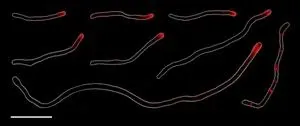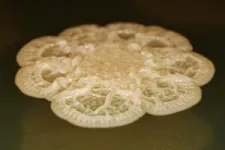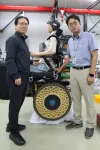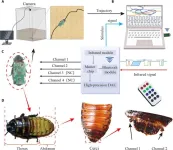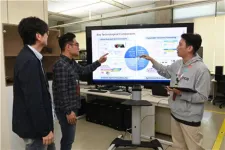(Press-News.org) By Emily Greenhalgh
One of the most diverse ecosystems on the planet is closer than you think — right inside your mouth. Your mouth is a thriving ecosystem of more than 500 different species of bacteria living in distinct, structured communities called biofilms. Nearly all of these bacteria grow by splitting [or dividing] into two, with one mother cell giving rise to two daughter cells.
New research from the Marine Biological Laboratory (MBL) and ADA Forsyth uncovered an extraordinary mechanism of cell division in Corynebacterium matruchotii, one of the most common bacteria living in dental plaque. The filamentous bacterium doesn’t just divide, it splits into multiple cells at once, a rare process called multiple fission. The research is published this week in Proceedings of the National Academy of Sciences.
The team observed C. matruchotii cells dividing into up to 14 different cells at once, depending on the length of the original mother cell. These cells also only grow at one pole of the mother filament—something called “tip extension.”
C. matruchotii filaments act as a scaffolding within dental plaque, which is a biofilm. Dental plaque is just one microbial community within an immense population of microorganisms that live in and coexist with a healthy human body—an environment known as the “human microbiome.” This discovery sheds light on how these bacteria proliferate, compete for resources with other bacteria, and maintain their structural integrity within the intricate environment of dental plaque.
“Reefs have coral, forests have trees, and the dental plaque in our mouths has Corynebacterium. The Corynebacterium cells in dental plaque are like a big, bushy tree in the forest; they create a spatial structure that provides the habitat for many other species of bacteria around them,” said paper co-author Jessica Mark Welch, senior scientist at ADA Forsyth and adjunct scientist at the MBL.
“These biofilms are like microscopic rainforests. The bacteria in these biofilms interact as they grow and divide. We think that the unusual C. matruchotii cell cycle enables this species to form these very dense networks at the core of the biofilm,” said Scott Chimileski, MBL research scientist and lead author on the paper.
The Microbial Forest
This research builds off of a 2016 paper that used an imaging technique developed at the MBL called CLASI-FISH (combinatorial labeling and spectral imaging fluorescent in situ hybridization) to visualize the spatial organization of dental plaque collected from healthy donors. This earlier study imaged bacterial consortia within dental plaque, which are called “hedgehogs” due to their appearance. One of the major findings from that original paper was that filamentous C. matruchotii cells acted as the basis of the hedgehog structure.
The present study took a deeper dive into the biology of C. matruchotii, using time-lapse microscopy to study how the filamentous cells grow. Rather than just capturing a snapshot of this microbial rainforest, the scientists were able to image bacterial growth dynamics of the miniature ecosystem in real time. They saw how these bacteria interact with each other, use the space, and—in the case of C. matruchotii—the incredible way they grow.
“To figure out how all the different kinds of bacteria work together in the plaque biofilm, we have to understand the basic biology of these bacteria, which live nowhere else but the human mouth,” said Mark Welch.
Dentists recommend brushing your teeth (and therefore brushing away dental plaque) twice a day. Yet this biofilm comes back no matter how diligently you brush. By extrapolating from cell elongation experiments measured in micrometers per hour, the scientists found that C. matruchotii colonies could grow up to a half a millimeter per day.
Other species of Corynebacterium are found elsewhere in the human microbiome, such as the skin and inside the nasal cavity. Yet the skin and nasal Corynebacterium species are shorter, rod-shaped cells that aren’t known to elongate by tip extension or divide by multiple fission.
“Something about this very dense, competitive habitat of the dental plaque may have driven the evolution of this way of growing,” said Chimileski.
Exploratory Growth
C. matruchotii lack flagella, the organelles that allow bacteria to move around. Since these bacteria can’t swim, researchers believe its unique elongation and cell division might be a way for it to explore its environment, similar to mycelial networks seen in fungi and Streptomyces bacteria that live in soil.
“If these cells have the ability to move preferentially towards nutrients or towards other species to form beneficial interactions — this could help us understand how the spatial organization of plaque biofilms comes about,” said Chimileski.
“Who would have thought that our familiar mouths would harbor a microbe whose reproductive strategy is virtually unique in the bacterial world,” said co-author Gary Borisy, principal investigator at ADA Forsyth and former director of the Marine Biological Laboratory. "The next challenge is to understand the meaning of this strategy for the health of our mouths and our bodies."
—###—
The Marine Biological Laboratory (MBL) is dedicated to scientific discovery – exploring fundamental biology, understanding marine biodiversity and the environment, and informing the human condition through research and education. Founded in Woods Hole, Massachusetts in 1888, the MBL is a private, nonprofit institution and an affiliate of the University of Chicago.
END
A new technology for wheels and mobile systems, necessary for overcoming various obstacles in daily life such as stairs or rocks by adjusting the stiffness of the wheel in real time, has been developed for the first time in the world. This noble technology is anticipated to find wide applications in various moving vehicles equipped with wheels, where overcoming terrain obstacles is essential.
The Korea Institute of Machinery and Materials (President Seog-Hyeon Ryu, hereinafter referred to as KIMM), an institute under the jurisdiction of the ...
Melbourne researchers have made a world first breakthrough into creating blood stem cells that closely resemble those in the human body. And the discovery could soon lead to personalised treatments for children with leukaemia and bone marrow failure disorders.
The research, led by Murdoch Children’s Research Institute (MCRI) and published in Nature Biotechnology, has overcome a major hurdle for producing human blood stem cells, which can create red cells, white blood cells and platelets, that closely match those in the human embryo.
MCRI Associate Professor Elizabeth Ng said the team had made a significant discovery in human blood stem ...
Genetic variants linked to a rare form of bicuspid aortic valve disease that affects young adults and can lead to dangerous and potentially life-threatening aortic complications have been identified by researchers at UTHealth Houston.
The study was published today in the American Journal of Human Genetics.
“We previously found that young individuals who present due to early onset thoracic aortic dissections are more likely to have bicuspid aortic valves and more likely to have rare variants in bicuspid aortic valve-associated genes,” said Siddharth Prakash, MD, PhD, co-principal investigator of the study and associate professor of medical ...
A research paper by scientists at Beijing Institute of Technology proposed a universal system for remote signal output control using infrared signals.
The new research paper, published on Jul. 05 in the journal Cyborg and Bionic Systems, proposed a system that integrates high-precision digital-to-analog converters capable of generating customized waveform electrical stimulation signals within defined ranges. This enhances the accuracy of locomotion control in cyborg insects while maintaining real-time control and dynamic parameter adjustment. The proposed system is verified by experiments.
The integration of electronic stimulation devices with insects in ...
A study on vaping behaviour among Australian high school students has found those who reported severe depressive symptoms were over twice as likely to have tried e-cigarettes, compared to those reporting no depressive symptoms.
Data showed overall higher e-cigarette use among those with poorer mental health, including severe depressive symptoms, moderate and high stress, and low wellbeing.
The findings show a critical need for effective mental health support at the same time as vaping prevention during early adolescence -- when these issues first emerge.
The researchers surveyed over ...
Korean researchers are pushing for a new AI-based policy intelligence research project that can assist the public decision-making and policy execution of domestic and foreign local governments.
Electronics and Communications Research Institute (ETRI) announced on July 1 that they have decided to establish a cooperative system with the International Institute for Applied Systems Analysis (IIASA)1) to conduct further research regarding the development of an AI policy intelligence system that can assist public policy decision-making.
1) International Institute for Applied Systems Analysis (IIASA): An independent international research institute located ...
About The Study: Pulmonary vein isolation resulted in a statistically significant and clinically important decrease in atrial fibrillation burden at 6 months, with substantial improvements in symptoms and quality of life, compared with a sham procedure.
Corresponding Authors: To contact the corresponding authors, email Rick A. Veasey, MD, (rick.veasey@nhs.net) and Rajdip Dulai, MBBS, (rajdip.dulai.21@ucl.ac.uk)
To access the embargoed study: Visit our For The Media website at this link https://media.jamanetwork.com/
(doi:10.1001/jama.2024.17921)
Editor’s ...
About The Study: At the lesion level, very intensive lipid-lowering therapy induced substantially greater percent atheroma volume regression than described in previous vessel-level analyses. Compared with statin therapy alone, alirocumab treatment was associated with greater enlargement of the lesion minimum lumen area and more frequent transition of presumably high-risk plaque phenotypes into more stable, less lipid-rich plaque phenotypes.
Corresponding Author: To contact the corresponding author, Lorenz ...
Alternative splicing is a genetic process where different segments of genes are removed, and the remaining pieces are joined together during transcription to messenger RNA (mRNA). This mechanism increases the diversity of proteins that can be generated from genes, by assembling sections of genetic code into different combinations. This is believed to enhance biological complexity by allowing genes to produce different versions of proteins, or protein isoforms, for many different uses.
New research from the University of Chicago suggests that alternative splicing may have an even greater influence on biology than just by creating new protein isoforms. The ...
Cities in the Global South are more exposed to extreme heat because they lack cooling green spaces, new research shows.
The study found that Global South cities have just 70% of the “cooling capacity” provided by urban greenery in the Global North.
With temperatures rising, combined with the “urban heat island” effects that make cities hotter than rural areas, heat-related illness and death in cities are becoming more common.
Urban green spaces can help reduce this risk, cooling down outdoor environments and providing vital refuges.
The research – led by an international team including Nanjing, Exeter, Aarhus and North Carolina State universities – ...

